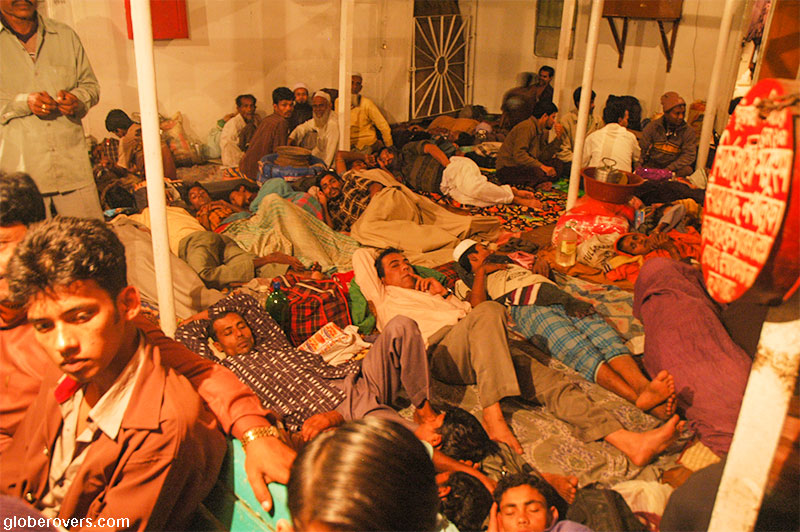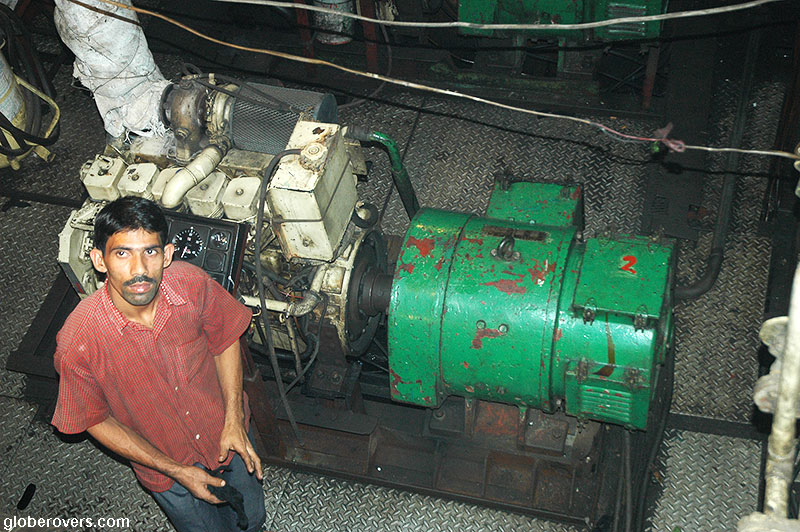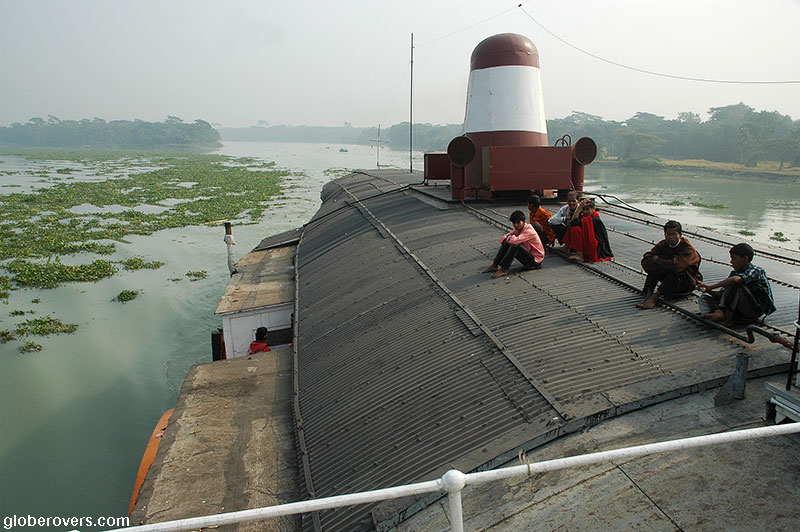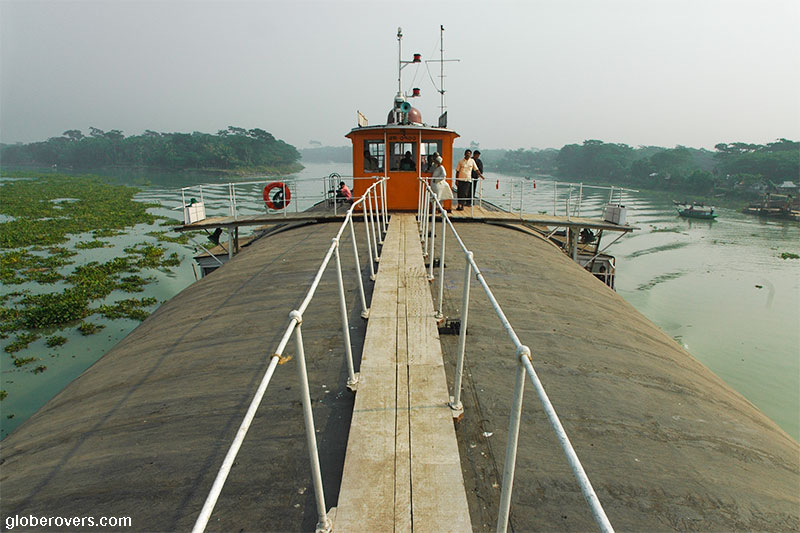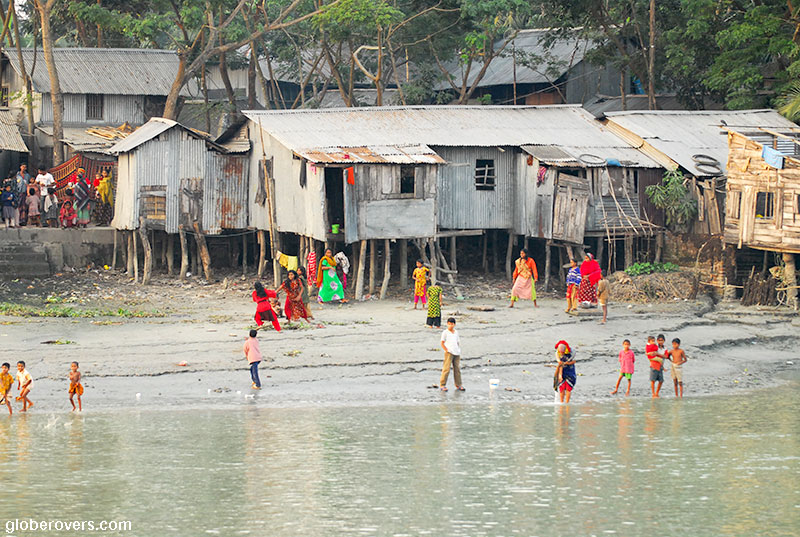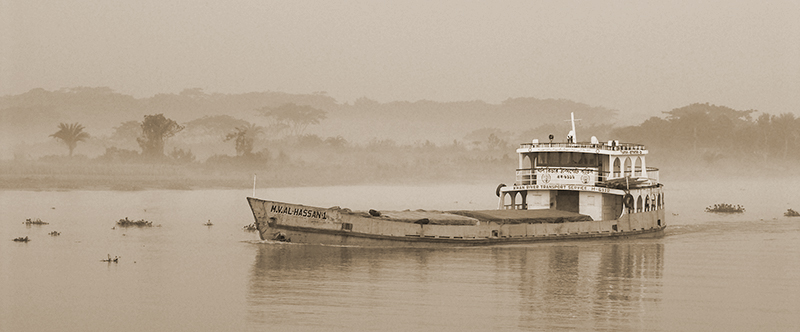
Nothing could prepare me for Bangladesh! It was not the thousands of rickshaws on the streets of Dhaka that fazed me. It was not the condition of the three-wheeled taxis, or the old busses, or the bustling markets, or the smoke polluted streets that shocked me. No, I have seen all of that before. I’ve been there. I have done that. Elsewhere.
In Bangladesh, it was a culture shock at an entirely different level.
Why travel to Bangladesh?
- The low-down: Bangladesh is mostly off the beaten track and if you are truly an adventurer, you will find many places that have never seen a non-Asian traveller. People are generally friendly and mostly shocked to see a foreign visitor.
- The brightest highlight: I most enjoyed the isolated areas where people told my guide that they have never seen a White person. It was amazing to interact with these people. In addition, the slums of Dhaka are such an eye-opener. Beautiful scenery in many parts of the country.
- Intrepid destination: Absolutely. Almost everywhere I went was void of any Western tourists, or likely any tourists from anywhere. The people truly appreciate any foreigners visiting them.
- Globerovers score (10 is highest): I was truly impressed with the people of Bangladesh and would love to go back. I’ll score Bangladesh 9.3 out of 10.
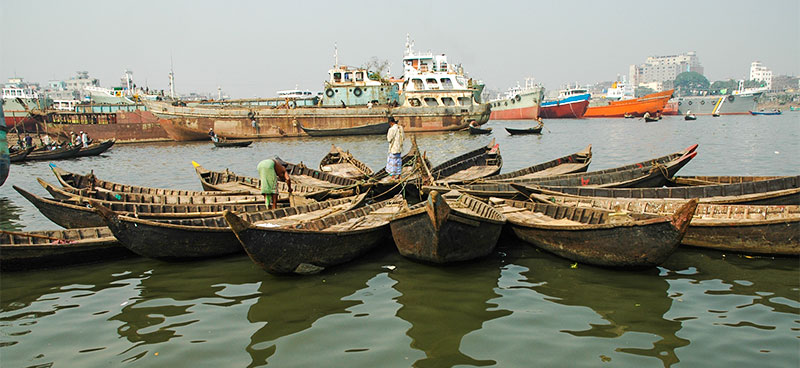
Table of Contents
The Bangladesh Culture Shock
It was the shock and surprise on the faces of people in remote villages when they first laid eyes on me, a white man. I travelled by small boat with my local guide to some very remote villages in the Bengal Delta where the village Chiefs told me that a white person had never been anywhere near the villages before. But, more about this later…
Dhaka, the “rickshaw capital of the world” will give you a great dose of culture shock!
Another culture shock of unrivalled proportion was my visit to the slums of Dhaka. It was not the poverty. I have seen poverty in Afghanistan, India, Yemen… In many places around the world, poverty is rife. Sure, in places like India and Bangladesh it is worse.
What really, yet pleasantly, shocked me, was the incredible hospitality among Dhaka’s utmost poor. I have to admit that all over Bangladesh I found the people to be friendly and inviting. In Dhaka’s slums, it was hospitality, generosity, warmth, kindness – there are no words to describe the people. I was treated like a god who descended from the heavens. But, more about this later…
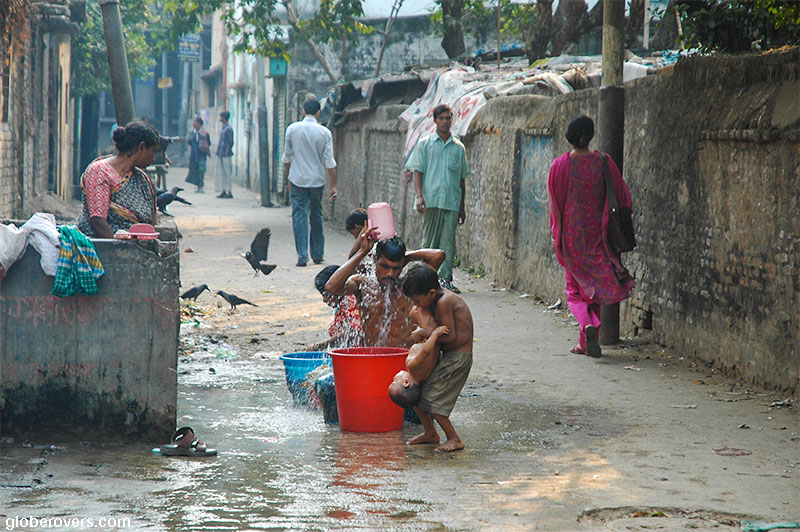
I have travelled the world far and wide. I normally travel solo, and I’m a true independent intrepid traveller which dictates that I shall not acquire the services of a local guide. I shall use my own resources and instincts to explore foreign destinations and stay off the beaten track as far as possible. In Bangladesh, I let go of all my rules. This was the only country of the more than one hundred I have explored to date where I booked a local guide ahead of my arrival date. And I stayed with my guide throughout my three-week travels.
Two brothers from Dhaka noted my enquiries on a travel forum and offered to show me their incredible country, at no charge. I reluctantly accepted their offer. As we travelled I appreciated my local guides more and more. In hindsight, I knew it would not have been possible without my guides. From Dhaka, we flew southeast to explore Chittagong and the Hill Tracts, then by the “Rocket Steamer” to the south. From here we ventured by small boat to the delta’s remote villages and the Sundarbans, home of the elusive Bengal tiger.
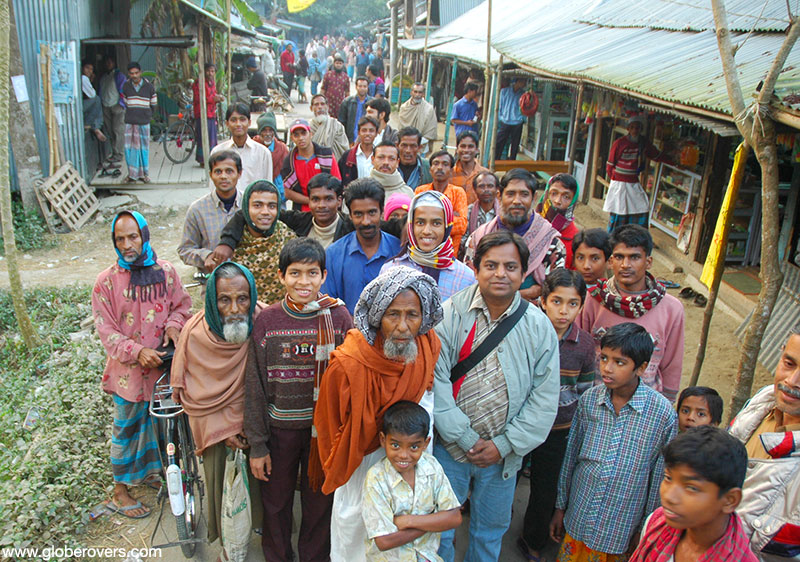
Exploring Chaotic Dhaka City
Dhaka, the capital of Bangladesh, is a city with more than 15 million inhabitants. Known as the “Rickshaw capital of the world”, Dhaka has about 225,000 of these vehicles on the road with many of them not licensed. About 38% of daily trips around the city are by rickshaw (walking accounts for a further 20% and travelling by car 5%).
Dhaka has about 225,000 rickshaws operated by about 800,000 men involving about 3 million people
While about 800,000 men are directly involved in the rickshaws, it is estimated that rickshaws in some way provide income to about 3 million people in a city with a per capita income of $3,100 and where 23% of people are unemployed.
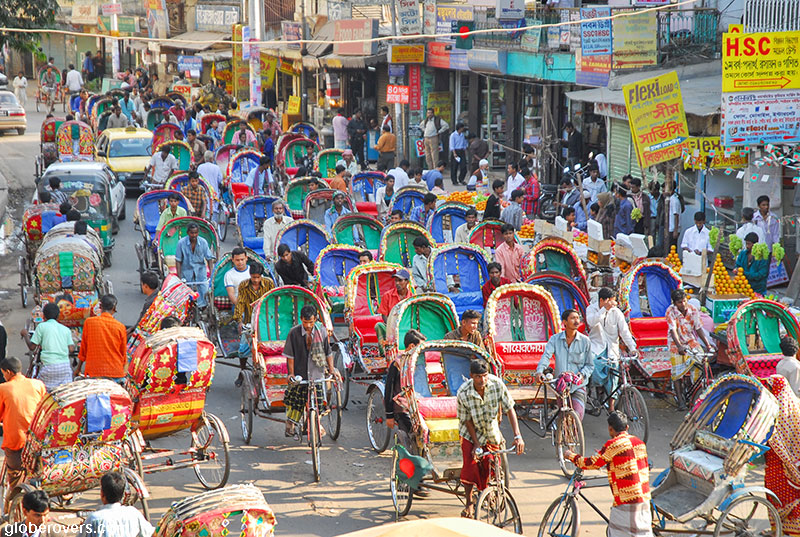

Located on the east banks of the Buriganga River, the old part of the city used to be called Jahangir Nagar during the 17th century. At that time, it was the Mughal Empire’s capital of the entire Bengal region known for its 700 rivers. The region included the Ganges-Brahmaputra delta system and the Himalayan states.
Founded in 1608, this old part of Dhaka is still inhabited today and it seems like no new buildings were constructed since its beginnings. Nowadays the old city is overcrowded, and in a sorrowful state where tens of thousands of Dhaka’s poorest of the poor live. About of quarter of its population is Hindu which brings a sense of vibrancy during the Hindu festivals.
If the old part of Dhaka is the heart of the city, then the Buriganga River is the main artery. From here large and small boats are launched to connect the capital with the rest of the country. Sadly, the river is in a dire state. Severely polluted by chemical-, medical-, and household waste, sewage, dead animals, plastics, oil and everything else, thousands of residents have to use the untreated waters from the river in their daily lives.
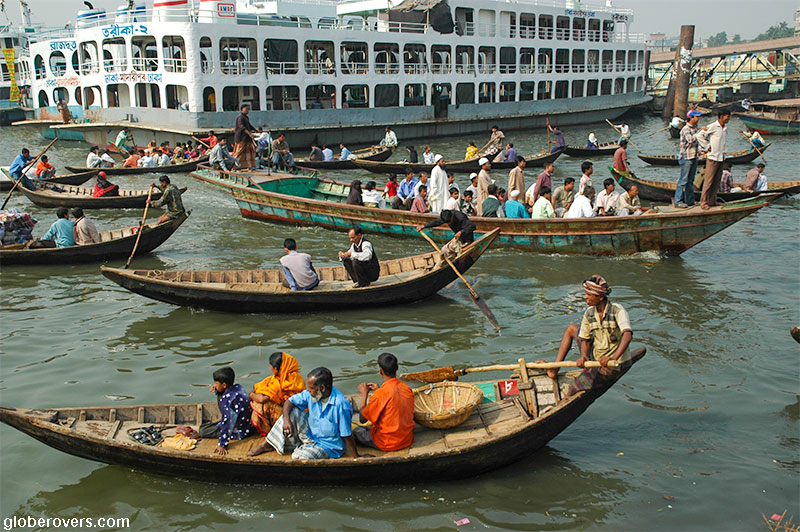
It is estimated that nearly 4 million people are exposed every day to the consequences of polluted water. At any time of the day, people can be seen bathing and brushing their teeth in the river, directly next to a large dumpsite of solid waste. This sight in itself is a massive shock to most outsiders.

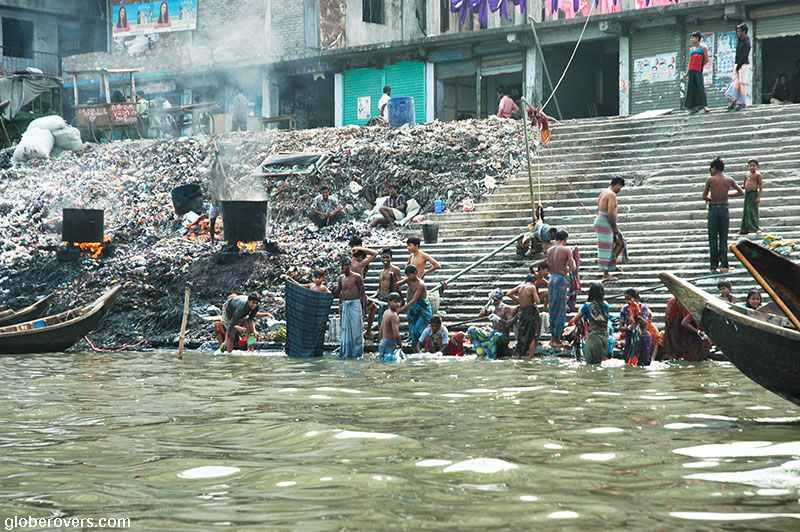
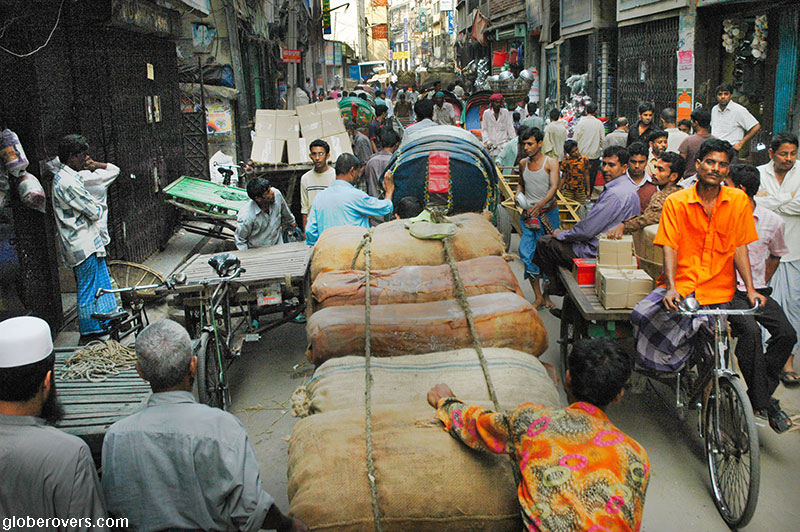
Walking around Dhaka, in particular, the slums of the old city, is truly an eye-opener. While the buildings are crumbling and overcrowded, residents are overly excited and welcome foreign tourists into their home. Don’t be surprised if residents run ahead and scramble to see who first can offer a cold drink from a nearby store. Hordes of friendly smiles will line the narrow pathways to get a glimpse of a passing foreigner. Most will extend their warmest welcome into their very modest homes just to have a photo taken with their visitor.
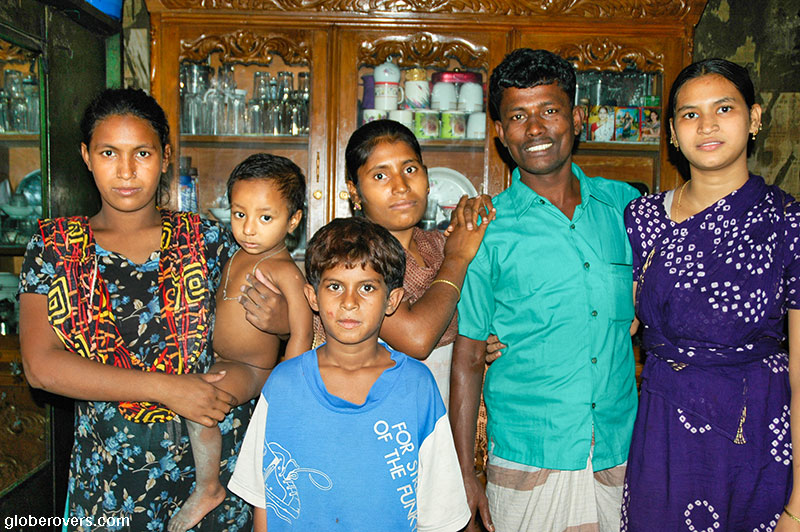
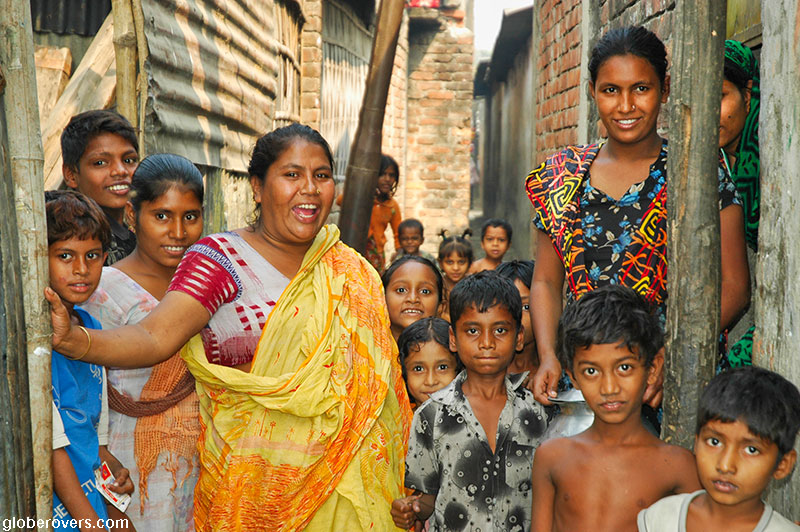
After a day of exploring Dhaka, it’s time to take a rest. In the newer suburbs are some funky cafes and restaurants serving delicious Bangladeshi cuisines.
Chittagong’s Ship-Breaking Yards
Located about 20 km northwest of the city of Chittagong, along the shallow waters of the Sitakunda coastal strip, are the infamous Chittagong Ship-Breaking Yards. As the world’s largest of their kind, they employ over 20,000 Bangladeshis, which range from teens to the elderly. Operators often find themselves in controversies related to mistreatment, employment of underage workers, low wages, and absence of the necessary protection in these dangerous working conditions.
With the right connections, you may enter the world of
Chittagong’s Ship-Breaking Yards
The ship-breaking industry started here in 1960 by accident when the Greek ship, the M D Alpine, was stranded in the tidal mud of this beach under the strong winds of a severe cyclone. Due to the shallow waters, attempts to refloat the ship were abandoned and it was left standing here for about five years until a steel company bought the ship in 1965 to have it dismantled and sell the salvaged steel. It took years of hard labour with mostly hand tools and dirt-cheap unskilled labourers to totally dismantle the ship.
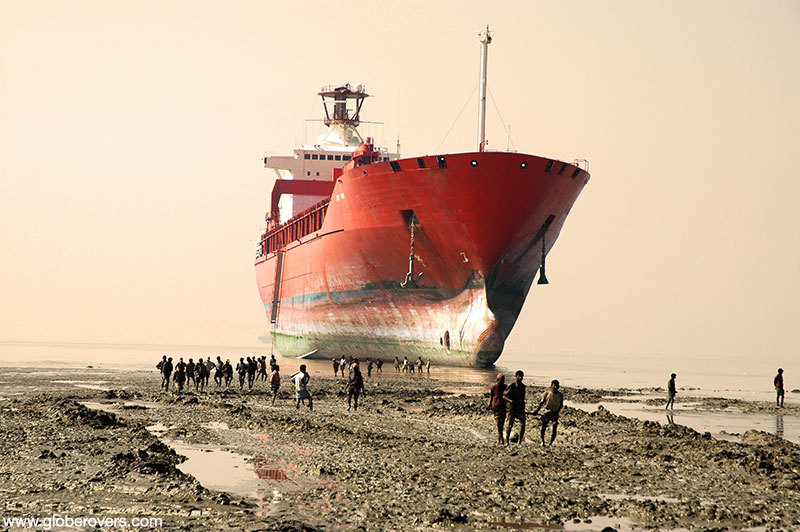
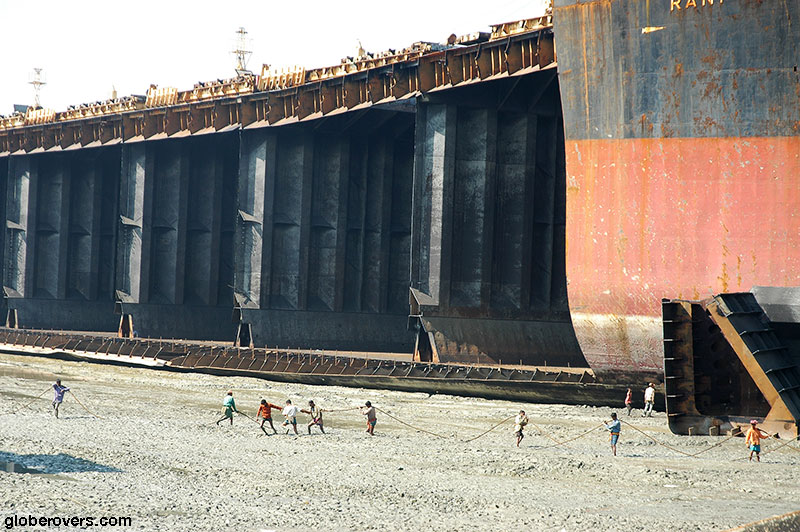
The steel company must have made good profits because since the first ship accidentally stranded, many more ships from around the world were forcibly stranded here to die slowly under the hands of the men with the blow-torches and hammers.
By 2009 the beach was lined with about 40 ship-breaking companies, which made them the largest of their kind in the world. A few years later this increased to 80! However, they no longer hold the top position. The Alang shipyards along the Gulf of Khambat in India’s Gujarat State are currently the largest and handle about half of all ship salvaging around the world.
There are several other ship-breaking yards around the world, including those in China, Pakistan, Turkey, United States, United Kingdom, and Belgium.
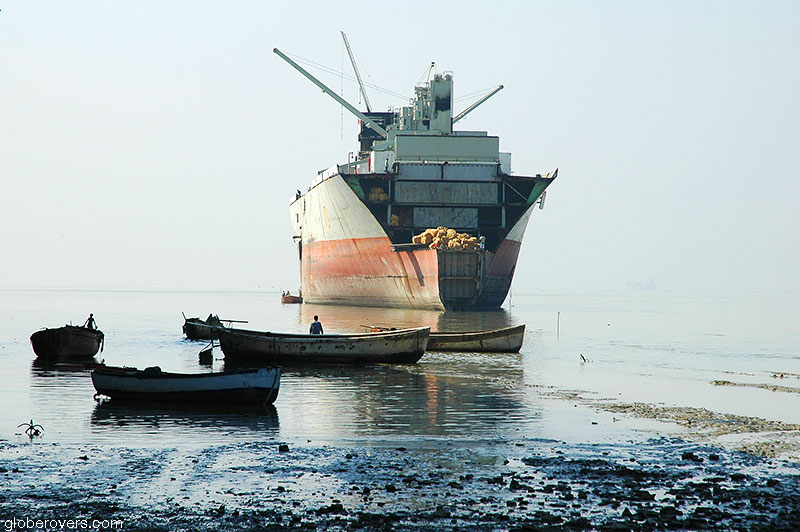

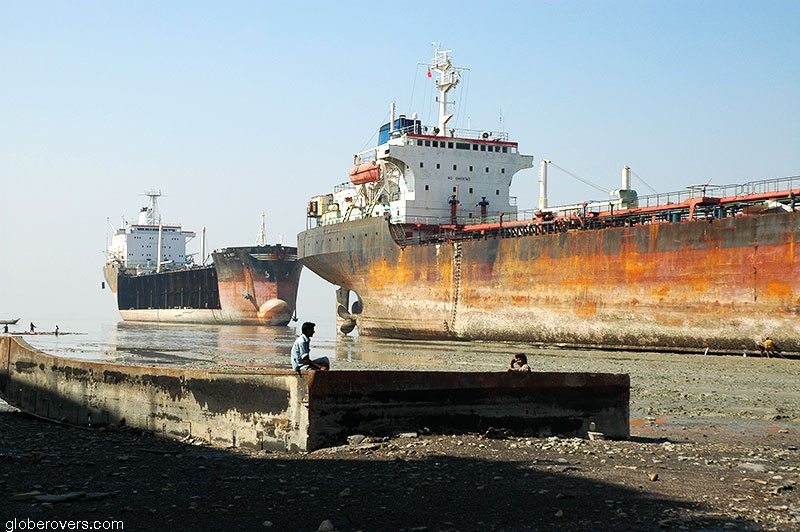
A group, critical of the Chittagong Ship-Breaking Yards, claims that on average one labourer dies here every week. The yards used to be a popular tourist attraction, but since investigative reporters from foreign media uncovered the abuse by company bosses and their total disregard for the welfare and safety of their grossly underpaid labourers, tourists and journalists are no longer welcome. It has also been reported that many of the labourers are teen boys who get paid as little as $1 for a full day shift.
For, example, a report by The Guardian newspaper in the U.K. reported the following headline: “The ship-breaking industry in Bangladesh has been widely condemned by international organisations in particular, for exposing low-paid workers to high levels of asbestos and contaminating the environment”. It showed photos of labourers working without any protection, and sleeping in crowded filthy hostel rooms.
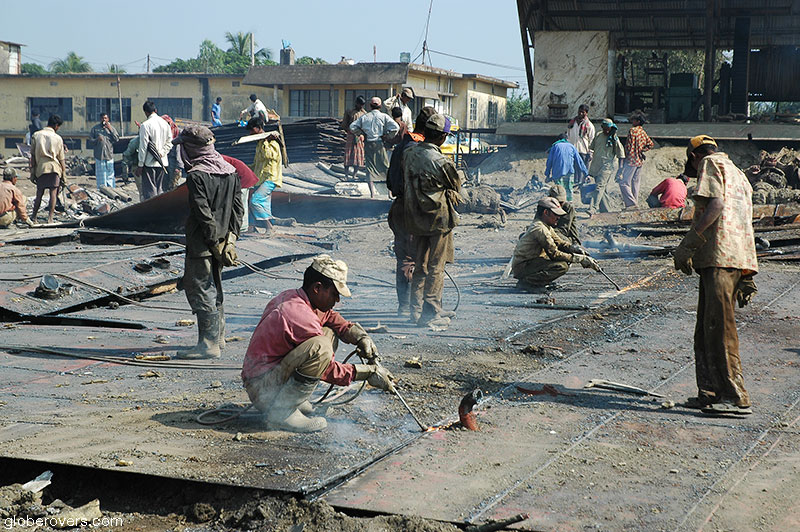
National Geographic magazine reported: “In Bangladesh men desperate for work perform one of the world’s most dangerous jobs”. As the many yards were secured behind high fences topped with razor wire, the reporter hired a fisherman with a boat to approach from the sea.
With a very skilful local guide who has connections with the company bosses, it is still possible to get inside. However, a pre-arranged site will be chosen for the visitor where the boss knows there are no underage labourers and where at least some basic protection such as gloves are provided. Photography will also be restricted to certain areas. These bosses are highly protective and sceptical of any visitors.
It truly is a sad but an interesting experience to see these huge ships being dismantled by nothing but human labour. If you can ever manage to get access, grab the opportunity.

Chittagong Hill Tracts Waterways
Prior to the signing of the “Chittagong Hill Tracts Peace Accord” in 1997, a 20-year armed struggle raged between the Government Forces and the armed wing of the United People’s Party of the Chittagong Hill Tracts. It was all about the autonomy and rights of the Buddhist and Hindu Jumma people and tribes of the Chittagong Hill Tracts.
Arrange an armed police escort to enter the
Chittagong Hill Tracts
The Government actions were described as “genocide and ethnic cleansing”. By 2013, Amnesty International reported that the Government still had not honoured the terms of the peace accord and returned land to the Jumma people. Some 90,000 Jumma families have been internally displaced.
The peace remains fragile. A couple of times foreigners who ventured here were kidnapped and only released after hefty ransoms were paid. As a precaution, foreigners who now want to enter the area must be heavily guarded by the local police force. A permit must first be obtained from the police station, at which time a small team of heavily armed policemen will escort the travellers through selected areas.

The Hill Tracts is an area in south-eastern Bangladesh, bordering India and Myanmar. It is a mountainous and rugged terrain with deep forests and several hill tribes collectively known as the Jumma. They differ remarkably in terms of language, culture, and appearance compared with the Bengali people who are the majority of the country.
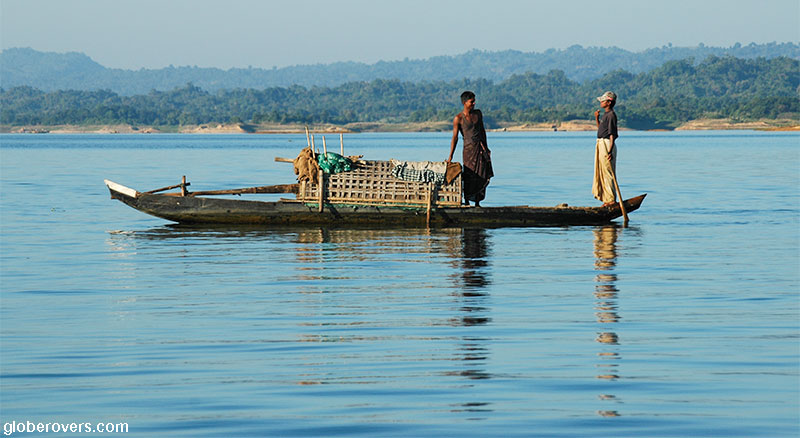
Century-old Rocket Steamer on the Ganges
All on board! The century-old Rocket is about to depart from Dhaka’s Sadarghat Ferry terminal down the Buriganga River to Khulna (354 km) in the southern delta. This is an experience of a lifetime and unrivalled anywhere. Old riverboats still exist in some countries, but going on the Rocket through the waterways of the Ganges-Brahmaputra Delta is like no place in the world.
Board the Rocket Steamer in Dhaka for an adventure
down the Buriganga River
“Rocket” is the name for the paddle steamer dating from the colonial period. Currently, four “classic” vessels are in service on the Dhaka-Morelganj-Khulna route: The Mahsud (built in 1929), Ostrich (1929), Lepcha (1937), and the Tern (1948). Built by the Denny Company (William Denny and Brothers Shipbuilders Limited) in the Scottish town of Dumbarton, they were originally steamers but were converted around 1995 to diesel engines. A smaller vessel, the Sela, was added in 2008.
The Rocket goes from Dhaka all the way to Morelganj or Khulna and makes brief stops in Chandpur, Barisal, Mongla and a few other lesser ports en route. If you are heading for the Sundarbans, the largest single block of tidal halophytic mangrove forest in the world, in search of the Bengal tigers, then you need to board the Rocket.
On board, three classes are available for the 20-28-hour journey to Morelganj or Khulna where the ferry turns around. However, timing can vary enormously depending on the navigability of the rivers at any given time. The front side of the upper level is first class and has 12 cabins in the large vessels and 8 in the smaller one. They have two single beds with clean linen, a washbasin, and a fan. Second class at the back of the boat has smaller rooms without a washbasin or bed linen. In the inter and deck spaces (third class) you literally sleep on the open deck.
You will be wise to reserve a first-class cabin, which also comes with meals, at least a month in advance. For a double cabin, the fare from Dhaka to Morelganj is about $50, one-way which is the new fare after a recent 40% increase.
Now that you know these boats are not exactly 100 years old and are no longer steamers, just enjoy the scenery along the way which makes this trip so memorable!

Boat ride on “The Rocket” from Dhaka to Barisal, Bangladesh 
Boat ride on “The Rocket” from Dhaka to Barisal, Bangladesh 
Boat ride on “The Rocket” from Dhaka to Barisal, Bangladesh 
Boat ride on “The Rocket” from Dhaka to Barisal, Bangladesh 
Village life along the river
Villages of the Ganges-Brahmaputra Delta
The southern delta reputedly has about 700 rivers, and many more canals and other waterways. Hire a good guide with a motorboat and set off into the unknown. The area has many small villages dotted along the waterways. Many of them are remote where most residents never get to the big cities such as Dhaka or Chittagong.
Meet the fascinating people in the small villages of the
Ganges-Brahmaputra Delta
In many of the villages, people have never seen non-Asians. If you are a non-Asian, people will stare at you as if you are from Mars. And furthermore, they will follow you all day long, hanging onto every movement you make and every word you speak. Don’t expect anybody to understand English, though.
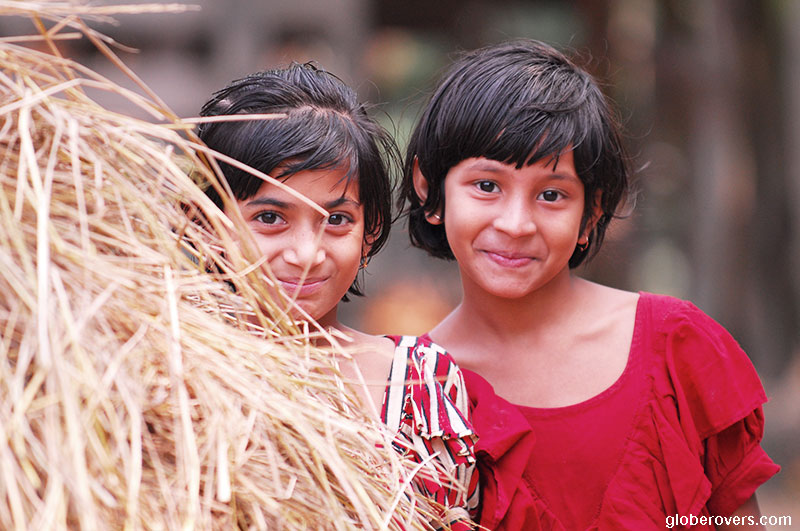


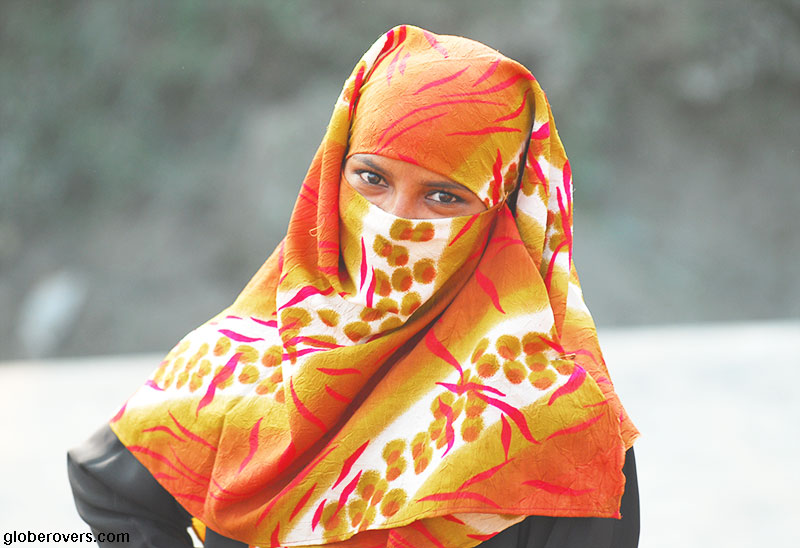
Two of the villages a few hours away by small boat from the town of Barisal along the Rocket route, are Sripur and Bamrail. At the time of my visit, the Chief of Sripur told me that I was the very first white person to ever visit the village. So, anybody coming after me can’t be the first! Should the Chief tell you that you are the first, then sadly he lied to you, or to me, or to many of us. Regardless of what the Chief told me, I could see from the reaction of the residents that they really thought I was from another planet.
Don’t be surprised if residents scramble for your attention and invite you inside their homes. One resident asked me to sit down while the lady made me a fried egg, complete with sugar. Upon asking my guide if they normally eat eggs with sugar, he told me they ate them with salt. Apparently, the lady thought, as a foreigner (possibly from Mars), I must eat my fried eggs with sugar.
Hike outside the villages to see farmers going about their daily lives and ploughing with their cows.
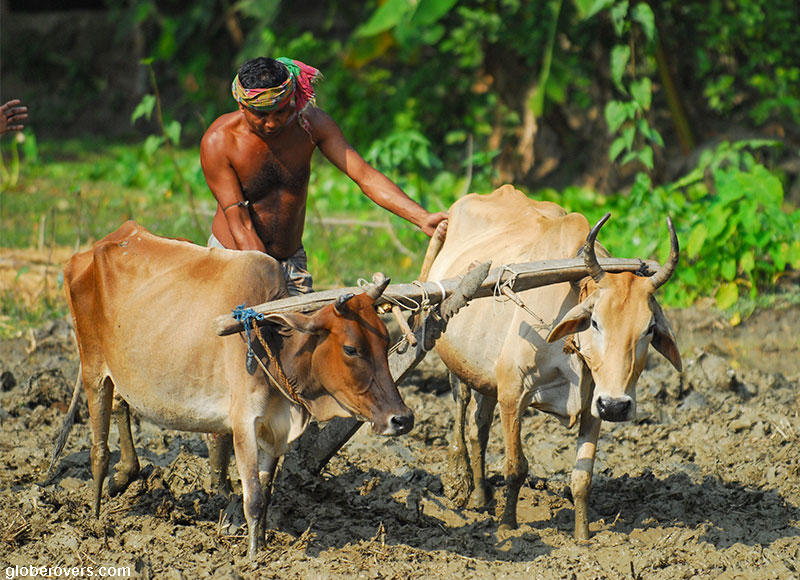
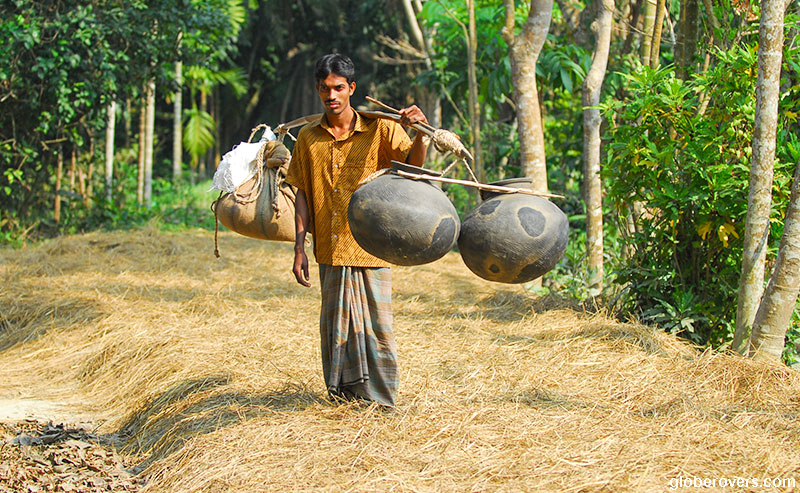
While accommodation here will have to be in the modest homes of locals, it sure will be an unforgettable time.
Let us not forget why we came to Bangladesh. Why we took the Rocket down the river. It was to explore the Sundarbans, the largest single block of tidal halophytic mangrove forest in the world. What we really want to see is the elusive Bengal tiger. However, don’t really expect to see the tigers.
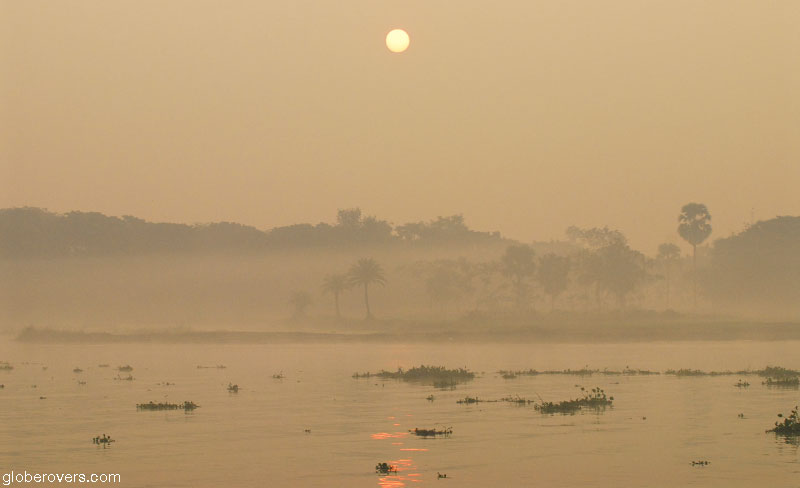
Even though the Sundarbans, which stretches across Bangladesh and India, is reportedly home to about one hundred Bengal tigers, don’t get your hopes too high regarding actually seeing one. But make no mistake. They are there! Every year the tigers kill several locals. These locals are mostly honey gatherers for which the mangroves are famous. Nothing as good as honey from the Sundarbans.
Fishermen on their small boats also sometimes fall prey to the swimming tigers. As entry to the Sundarbans National Tiger Reserve is controlled, you will be assigned a guide and a gunman complete with a sharp bayonet.
Watch out for the equally dangerous saltwater crocodile that grows to massive lengths.
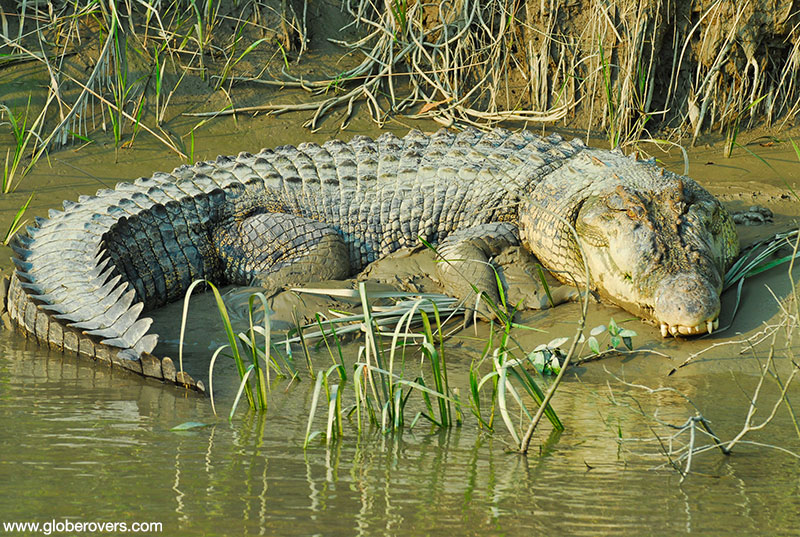
The mangroves are also home to the chital (spotted deer), leopard cats, jungle cats, macaques, wild boar, Indian grey mongoose, fox, flying fox, hawksbill turtle, mangrove horseshoe crab, and the armoured pangolin.

Essential Information
Getting There
Most international arrivals are by flying into the Hazrat Shahjalal International Airport (formerly known as Zia International Airport) on airlines such as the national carrier Biman Bangladesh Airlines, India’s Jet Air, Hong Kong’s Dragon Air, Singapore Airlines, Emirates, AirAsia, AirArabia, Etihad, Thai Airways, and a few others.
Getting Around
It is better to fly to far-away destinations such as Chittagong, Sylhet, Saidpur, and Cox’s Bazar. Take the Rocket Steamer to southern destinations such as Barisal, Mongla and Khulna. Railway coverage is extensive to the southeast (Chittagong) and to the north and northeast. Alternatively, rent a car and driver.
Location
Bangladesh is located to the east, west, and south of India. Towards the southeast it borders Myanmar. In the southern delta are the many friendly villages along the vast network of rivers and canals. To the southeast is Chittagong, the Hill Tracts, and the long beach of Cox’s Bazar. Tea plantations are in the north around Sylhet.
When to Go
The best time to visit Bangladesh is during the cool season (October to March). The absolute best time of the year is from November through February while May to September is monsoon season and the worst time.
Where to Stay
Dhaka has a variety of hotels fit for all budgets. So does Chittagong. However, outside the two largest cities, comfortable accommodation is very scarce. In the villages your guide will arrange homestay with the locals.
Packing
If you go during the “cool season”, take your summer clothes. Some places are plagued with biting insects so take thin long sleeve shirts and long pants to wear at night. Always dress conservatively.
Chill Out
Depending on your way of chilling out, Bangladesh offers a variety. Whether you want to be among the small villages, tea plantations, rivers, or on the world’s longest beach at Cox’s Bazar, relax and take life easy!
Train Journeys
The train operator is the state-run Bangladesh Railways. Prices are comparable to bus prices, but best to travel in 1st class. Try the Kolkata (India) to Dhaka by ‘Maitree Express’ train, or the Dhaka to Chittagong trip.
Cost of Travel
Bangladesh is not expensive unless you want to splurge in Dhaka. Solo trips by car or boat can be expensive, but still very reasonable. If domestic flights are booked well in advance then they are not expensive either.
☛ Read more: 10 Reasons to explore Bangladesh
☛ Read more: A day in the life of Bangladesh

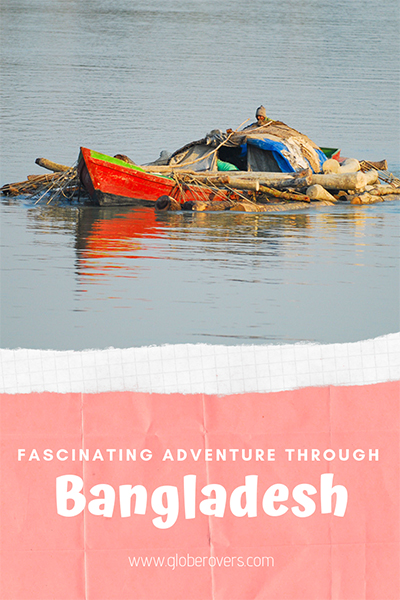
Further reading
- The ultimate guide to backpacking in Bangladesh
- 10 Things to Expect From Dhaka
- 10 things nobody tells you about traveling Bangladesh

Blog post and photos by Peter who has been travelling almost full-time since 2005 and has been to over 122 countries. He visited several countries, such as Japan, more than 20 times. Peter is Editor-in-Chief and Publisher of GlobeRovers Magazine, an independent travel magazine focused on intrepid destinations.

